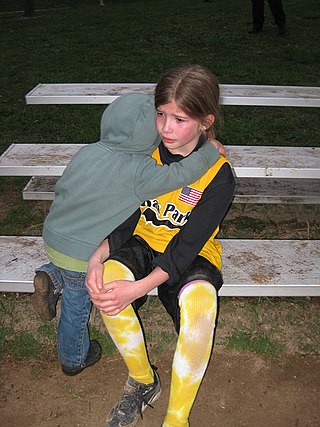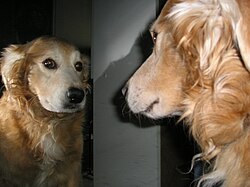
Consciousness, at its simplest, is awareness of internal and external existence. However, its nature has led to millennia of analyses, explanations and debate by philosophers, theologians, and scientists. Opinions differ about what exactly needs to be studied or even considered consciousness. In some explanations, it is synonymous with the mind, and at other times, an aspect of mind. In the past, it was one's "inner life", the world of introspection, of private thought, imagination and volition. Today, it often includes any kind of cognition, experience, feeling or perception. It may be awareness, awareness of awareness, or self-awareness either continuously changing or not. The disparate range of research, notions and speculations raises a curiosity about whether the right questions are being asked.
Artificial consciousness (AC), also known as machine consciousness (MC), synthetic consciousness or digital consciousness, is the consciousness hypothesized to be possible in artificial intelligence. It is also the corresponding field of study, which draws insights from philosophy of mind, philosophy of artificial intelligence, cognitive science and neuroscience. The same terminology can be used with the term "sentience" instead of "consciousness" when specifically designating phenomenal consciousness.
An altered state of consciousness (ASC), also called an altered state of mind, altered mental status (AMS) or mind alteration, is any condition which is significantly different from a normal waking state. By 1892, the expression was in use in relation to hypnosis, though there is an ongoing debate as to whether hypnosis is to be identified as an ASC according to its modern definition. The next retrievable instance, by Max Mailhouse from his 1904 presentation to conference, however, is unequivocally identified as such, as it was in relation to epilepsy, and is still used today. In academia, the expression was used as early as 1966 by Arnold M. Ludwig and brought into common usage from 1969 by Charles Tart. It describes induced changes in one's mental state, almost always temporary. A synonymous phrase is "altered state of awareness".

Empathy is generally described as the ability to take on another's perspective, to understand, feel, and possibly share and respond to their experience. There are more definitions of empathy that include but is not limited to social, cognitive, and emotional processes primarily concerned with understanding others. Often times, empathy is considered to be a broad term, and broken down into more specific concepts and types that include cognitive empathy, emotional empathy, somatic empathy, and spiritual empathy.

Cetacean intelligence is the overall intelligence and derived cognitive ability of aquatic mammals belonging in the infraorder Cetacea (cetaceans), including baleen whales, porpoises, and dolphins. In 2014, a study found for first time that the long-finned pilot whale has more neocortical neurons than any mammal studied to date, including humans.
In psychology, theory of mind refers to the capacity to understand other people by ascribing mental states to them. A theory of mind includes the knowledge that others' beliefs, desires, intentions, emotions, and thoughts may be different from one's own. Possessing a functional theory of mind is crucial for success in everyday human social interactions. People utilize a theory of mind when analyzing, judging, and inferring others' behaviors. The discovery and development of theory of mind primarily came from studies done with animals and infants. Factors including drug and alcohol consumption, language development, cognitive delays, age, and culture can affect a person's capacity to display theory of mind. Having a theory of mind is similar to but not identical with having the capacity for empathy or sympathy.
Awareness in philosophy and psychology is a concept about knowing, perceiving and being cognizant of events. Another definition describes it as a state wherein a subject is aware of some information when that information is directly available to bring to bear in the direction of a wide range of behavioral actions. The concept is often synonymous to consciousness and is also understood as being consciousness itself.
Anosognosia is a condition in which a person with a disability is cognitively unaware of having it due to an underlying physical condition. Anosognosia results from physiological damage to brain structures, typically to the parietal lobe or a diffuse lesion on the fronto-temporal-parietal area in the right hemisphere, and is thus a neuropsychiatric disorder. A deficit of self-awareness, the term was first coined by the neurologist Joseph Babinski in 1914, in order to describe the unawareness of hemiplegia.

The mirror test—sometimes called the mark test, mirror self-recognition (MSR) test, red spot technique, or rouge test—is a behavioral technique developed in 1970 by American psychologist Gordon Gallup Jr. as an attempt to determine whether an animal possesses the ability of visual self-recognition. The MSR test is the traditional method for attempting to measure physiological and cognitive self-awareness. However, agreement has been reached that animals can be self-aware in ways not measured by the mirror test, such as distinguishing between their own and others' songs and scents, and being aware of their own bodies, while humans have abnormally good vision, and thus intelligence that is highly visual.
Mirrored-self misidentification is the delusional belief that one's reflection in the mirror is another person – typically a younger or second version of one's self, a stranger, or a relative. This delusion occurs most frequently in patients with dementia and an affected patient maintains the ability to recognize others' reflections in the mirror. It is caused by right hemisphere cranial dysfunction that results from traumatic brain injury, stroke, or general neurological illness. It is an example of a monothematic delusion, a condition in which all abnormal beliefs have one common theme, as opposed to a polythematic delusion, in which a variety of unrelated delusional beliefs exist. This delusion is also classified as one of the delusional misidentification syndromes (DMS). A patient with a DMS condition consistently misidentifies places, objects, persons, or events. DMS patients are not aware of their psychological condition, are resistant to correction and their conditions are associated with brain disease – particularly right hemisphere brain damage and dysfunction.

The difficulty of defining or measuring intelligence in non-human animals makes the subject difficult to study scientifically in birds. In general, birds have relatively large brains compared to their head size. Furthermore, bird brains have two-to-four times the neuron packing density of mammal brains, for higher overall efficiency. The visual and auditory senses are well developed in most species, though the tactile and olfactory senses are well realized only in a few groups. Birds communicate using visual signals as well as through the use of calls and song. The testing of intelligence in birds is therefore usually based on studying responses to sensory stimuli.

Emotion is defined as any mental experience with high intensity and high hedonic content. The existence and nature of emotions in non-human animals are believed to be correlated with those of humans and to have evolved from the same mechanisms. Charles Darwin was one of the first scientists to write about the subject, and his observational approach has since developed into a more robust, hypothesis-driven, scientific approach. Cognitive bias tests and learned helplessness models have shown feelings of optimism and pessimism in a wide range of species, including rats, dogs, cats, rhesus macaques, sheep, chicks, starlings, pigs, and honeybees. Jaak Panksepp played a large role in the study of animal emotion, basing his research on the neurological aspect. Mentioning seven core emotional feelings reflected through a variety of neuro-dynamic limbic emotional action systems, including seeking, fear, rage, lust, care, panic and play. Through brain stimulation and pharmacological challenges, such emotional responses can be effectively monitored.

Mirroring is the behavior in which one person subconsciously imitates the gesture, speech pattern, or attitude of another. Mirroring often occurs in social situations, particularly in the company of close friends or family, often going unnoticed by both parties. The concept often affects other individuals' notions about the individual that is exhibiting mirroring behaviors, which can lead to the individual building rapport with others.
Somatoparaphrenia is a type of monothematic delusion where one denies ownership of a limb or an entire side of one's body. Even if provided with undeniable proof that the limb belongs to and is attached to their own body, the patient produces elaborate confabulations about whose limb it really is or how the limb ended up on their body. In some cases, delusions become so elaborate that a limb may be treated and cared for as if it were a separate being.

Animal consciousness, or animal awareness, is the quality or state of self-awareness within an animal, or of being aware of an external object or something within itself. In humans, consciousness has been defined as: sentience, awareness, subjectivity, qualia, the ability to experience or to feel, wakefulness, having a sense of selfhood, and the executive control system of the mind. Despite the difficulty in definition, many philosophers believe there is a broadly shared underlying intuition about what consciousness is.
Infant cognitive development is the first stage of human cognitive development, in the youngest children. The academic field of infant cognitive development studies of how psychological processes involved in thinking and knowing develop in young children. Information is acquired in a number of ways including through sight, sound, touch, taste, smell and language, all of which require processing by our cognitive system. However, cognition begins through social bonds between children and caregivers, which gradually increase through the essential motive force of Shared intentionality. The notion of Shared intentionality describes unaware processes during social learning at the onset of life when organisms in the simple reflexes substage of the sensorimotor stage of cognitive development do not maintain communication via the sensory system.
The sense of agency (SoA), or sense of control, is the subjective awareness of initiating, executing, and controlling one's own volitional actions in the world. It is the pre-reflective awareness or implicit sense that it is I who is executing bodily movement(s) or thinking thoughts. In non-pathological experience, the SoA is tightly integrated with one's "sense of ownership" (SoO), which is the pre-reflective awareness or implicit sense that one is the owner of an action, movement or thought. If someone else were to move your arm you would certainly have sensed that it were your arm that moved and thus a sense of ownership (SoO) for that movement. However, you would not have felt that you were the author of the movement; you would not have a sense of agency (SoA).
Secondary consciousness is an individual's accessibility to their history and plans. The ability allows its possessors to go beyond the limits of the remembered present of primary consciousness. Primary consciousness can be defined as simple awareness that includes perception and emotion. As such, it is ascribed to most animals. By contrast, secondary consciousness depends on and includes such features as self-reflective awareness, abstract thinking, volition and metacognition. The term was coined by Gerald Edelman.
The activation-synthesis hypothesis, proposed by Harvard University psychiatrists John Allan Hobson and Robert McCarley, is a neurobiological theory of dreams first published in the American Journal of Psychiatry in December 1977. The differences in neuronal activity of the brainstem during waking and REM sleep were observed, and the hypothesis proposes that dreams result from brain activation during REM sleep. Since then, the hypothesis has undergone an evolution as technology and experimental equipment has become more precise. Currently, a three-dimensional model called AIM Model, described below, is used to determine the different states of the brain over the course of the day and night. The AIM Model introduces a new hypothesis that primary consciousness is an important building block on which secondary consciousness is constructed.










